Gregory A. Fournier's Blog, page 62
August 7, 2011
Detroit Shout Out 3 - The Charles H. Wright Museum of African American History
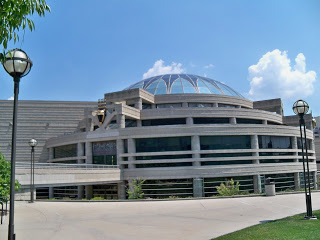 A wonderful surprise on the last stop of my Zug Island: A Detroit Riot Novel book tour in Detroit was The Charles H. Wright Museum of African American History on E. Warren Ave. This awesome building sits nicely on a landscaped city block, flanked by the Detroit Institute of Arts on one end and adjacent to the Detroit Science Center on another. For people who think modern architecture lacks style and passion, they need to see this unique museum. This building is just one of a number of signs that this city is far from defeated.
A wonderful surprise on the last stop of my Zug Island: A Detroit Riot Novel book tour in Detroit was The Charles H. Wright Museum of African American History on E. Warren Ave. This awesome building sits nicely on a landscaped city block, flanked by the Detroit Institute of Arts on one end and adjacent to the Detroit Science Center on another. For people who think modern architecture lacks style and passion, they need to see this unique museum. This building is just one of a number of signs that this city is far from defeated. The museum has two levels crowned by an eye catching glass and steel dome which covers the Ford Freedom Rotunda on the upper level. The dome illuminates the Ring of Genealogy centered beneath it on the floor. The ring is comprised of brass tiles engraved with the names of notable African-Americans from American history. The General Motors Theater, the Museum Store, the Research Library, and the four exhibit areas radiate from this expansive, circular public area. The lower level is dedicated primarily to the museum's educational mission with classrooms, an Orientation Theater, a large Multipurpose Room, and an exhibit on the Tuskegee Airmen Project. The museum café is also on this level. This is one of the best museums I've been to in the United States. It was an honor to speak here about about my novel, Zug Island. Many thanks to the museum staff for being so helpful and making me feel welcome.
The museum has two levels crowned by an eye catching glass and steel dome which covers the Ford Freedom Rotunda on the upper level. The dome illuminates the Ring of Genealogy centered beneath it on the floor. The ring is comprised of brass tiles engraved with the names of notable African-Americans from American history. The General Motors Theater, the Museum Store, the Research Library, and the four exhibit areas radiate from this expansive, circular public area. The lower level is dedicated primarily to the museum's educational mission with classrooms, an Orientation Theater, a large Multipurpose Room, and an exhibit on the Tuskegee Airmen Project. The museum café is also on this level. This is one of the best museums I've been to in the United States. It was an honor to speak here about about my novel, Zug Island. Many thanks to the museum staff for being so helpful and making me feel welcome.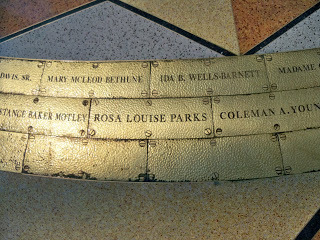
In addition to its museum and education functions, this venue can be hired out for business, corporate, public, or private gatherings with a full array of services. The Charles H. Wright Museum is truly a community resource and a welcome addition to Detroit's long overdue recovery. For more details, check out their website at www.CharlesHWrightMuseum.org.
Published on August 07, 2011 00:00
August 3, 2011
Michigan Mania - The Ann Arbor Art Fair
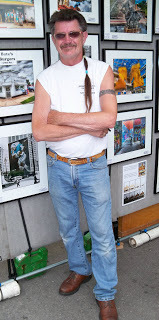 On my recent trip to Michigan to promote my novel, Zug Island, I stopped by the Ann Arbor Art Fair held annually in July on the University of Michigan campus. I hadn't been there in over thirty years, so I was anxious to go again.
On my recent trip to Michigan to promote my novel, Zug Island, I stopped by the Ann Arbor Art Fair held annually in July on the University of Michigan campus. I hadn't been there in over thirty years, so I was anxious to go again.Despite a punishing heat wave and threats of thunderstorms, the crowds braved the weather and made Michigan's premier art event a success once again. Artists from all over the country come to display and sell their art work, their crafts, and their unique clothing.
"This is my biggest venue of the year," says Jan Kaulins, a photographer and print artist from Manitou Beach, Michigan. "This is my busiest time and most important event; I've been coming here for longer than I care to admit."
This sample of his work, "Liberty and State - Ann Arbor," was created from nine individual bracketed digital exposures which produced this high dynamic range photograph. The subjects of his work feature Michigan and Detroit sights accented with his distinctive flair for color.
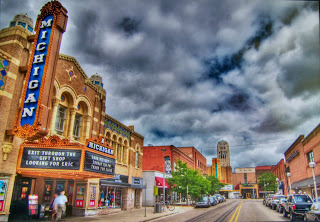 If my memory serves me right, the art work and displays at the Ann Arbor Art Fair have always been top notch, but one thing is definitely better than I remember from the past - the food. The variety and quality of the ethnic fare was better than many sit down restaurants I've been to lately. I can't wait to come back again.
If my memory serves me right, the art work and displays at the Ann Arbor Art Fair have always been top notch, but one thing is definitely better than I remember from the past - the food. The variety and quality of the ethnic fare was better than many sit down restaurants I've been to lately. I can't wait to come back again.Michigan Artist - Jan Kaulins- link
Published on August 03, 2011 00:00
July 31, 2011
Detroit Shout Out 2 - Zug Island, the Firemen, and the Police
 A couple of days before my first book talk, I decided to cruise the Detroit Riot areas and look at the current state of some of the neighborhoods. There are still signs of the devastation, but much of the area has been cleaned up, the vacant lots awaiting reinvestment and redevelopment, thanks to Detroit mayor, Dave Bing.
A couple of days before my first book talk, I decided to cruise the Detroit Riot areas and look at the current state of some of the neighborhoods. There are still signs of the devastation, but much of the area has been cleaned up, the vacant lots awaiting reinvestment and redevelopment, thanks to Detroit mayor, Dave Bing.One area I drove through was old Delray, now, all but a fading memory. Most of the buildings have been razed, but so has some of the rust belt industry. The Solvey Chemical works has been taken out, and Scott Paper is no longer there, but Zug Island still dominates the skyline. I don't think the three blast furnaces are operating, but the battery of coke ovens still belches out smoke and steam like clockwork.
In the past, I've been denied admittance to the island to do research for my novel. Zug Island is now a Homeland Security Facility. I took another approach this time. Driving up to the security booth, I rolled down my car's window and waited for someone to come out of the shack. When I showed the security guard a postcard with my novel's cover and title on it, I knew I had his interest. By this time, a second guard wanted to see what was taking soon long. I pitched my novel for three minutes and they agreed to pass out a bunch of bookmarks for me at the plant. Then I turned the car around and left. If nothing else, my visit will generate some conversation.
Fresh from that success, I saw the only building still open for business in Delray, the local fire station. It struck me that the fire fighters are part of the Detroit riot story, so I walked into the fire hall. A fireman took me in to talk with the chief in his air conditioned office. "What's it about?" the chief asked.

"That monstrosity across the street," I answered. I gave them my mini-pitch, which they were very interested in. They agreed to put some of my bookmarks in their mailbox room.
The chief suggested I should go to the area's main station house at the Southwestern Safety Center."Joe over there is crazy about anything about Detroit. You should go over there," he told me.
The center has a police station next to the parking lot, so I went in there first with the same story. By now, I had perfected my pitch. They took some bookmarks and wished me well. The fire hall was on the opposite side of the building, so I walked around and found someone polishing the chrome on a fire truck. "Hey!" I said. But before I got too far into my pitch, the fireman said, "Come into our lunchroom. The guys are eating back there."
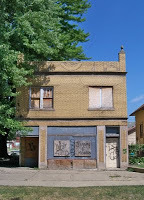 Six or seven firefighters were waiting around for the next emergency run. "Hey! This guy is an author and he wants to talk to you." At that, they all stopped what they were doing and politely listened. I left the rest of my promotional materials there with them. What an interesting day in the neighborhood!
Six or seven firefighters were waiting around for the next emergency run. "Hey! This guy is an author and he wants to talk to you." At that, they all stopped what they were doing and politely listened. I left the rest of my promotional materials there with them. What an interesting day in the neighborhood!I was feeling pretty good, so I decided to try and find the house I spent the first five years of my life in. I hadn't been back to the old place since we moved out in 1953, but it wasn't far from Zug Island. As I drove down Oakwood Blvd, I recognized a brick building and turned right. It was a soda shop on the corner of our street, now boarded up but not burned down. I remember my grandmother buying me penny candy there, and if she had any extra change, she bought ice cream cones for my brother and me.
[image error]
I turned left and found our address - 444 Bayside St. There it was, a vacant lot. All of the other homes on this short, three block street were intact and lived in but ours.
Sometimes, it is too late to go back home. Still, I can't believe I found the spot after fifty-eight years. What I wouldn't give for one of those ice cream cones now.
Published on July 31, 2011 00:00
July 28, 2011
Detroit Shout Out 1 - Duffield Public Library
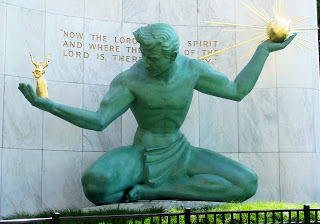
Thomas Wolfe once wrote, "You Can't Go Home Again." I just returned from Detroit, and I wanna tell you, he was wrong. After more years than I care to admit, I flew into my hometown for a Zug Island mini-book tour and was warmly greeted with courtesy by everyone I came into contact with.
Detroit's Duffield Public Library on West Grand Blvd. was my first stop. It was 100 degrees outside and even warmer in the almost 100 year old building. An African-American woman in her fifties, walking on a wooden cane, braved the heat and climbed a flight of stairs where it was even warmer, just to hear me speak about the Detroit Riots of 1967.
I'm not going to kid you, this woman took me to school on the Detroit Riots. She was fascinating as she reminisced about being a twelve year old girl at the time. "I was standing on my front porch watching people running towards the stores and others riding new bicycles in the opposite direction.
I ran in the house and yelled up the landing to my mother. 'Mom! Why are all those kids riding new bikes?' She came down and looked out the front door; then she locked it. It stayed that way for a week. I remember it. It was hot, like today."
When my presentation was over, we kept talking as we carefully walked down the stairs and the handicapped ramp onto the steamy boulevard. My rental car was parked right in front of the library. "Can I take you anywhere?"
"No," she said. "I have a bus pass."
"I have new air conditioning and it's almost too frosty."
I think I made a friend. She needed to go across town to the main branch of the post office on Fort St., and she told me wonderful stories about the city as we drove through Detroit's almost deserted streets. She pointed out the new Motown housing development with streets named after Motown acts and stars. She told me about the gambling palaces that cleaned out some of the slums and then fleeced the people. "You know," she said, "there are more churches and donut shops in Detroit than anyplace."
"No. I didn't know that," I said as we arrived at the post office. She thanked me for the ride and the conversation. I hadn't felt this connected to the city in over forty years. I am sad that I don't even remember the woman's name. I hope she likes my novel.
Published on July 28, 2011 15:13
July 25, 2011
Blast from the Past
I received an interesting letter the other day from a college friend of mine with a forty year old, yellowed news clipping in it dated March 15th, 1971. Our university newspaper, The Eastern Echo, interviewed me about a poetry reading I was about to give, my first of two. I had forgotten about it.
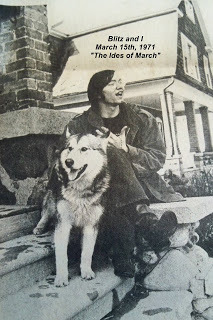 There I am in a photograph, twenty-two years old and looking gaunt, with my trusty companion, Blitz, who is wondering when we are going for our walk. I'm spouting off about one thing or another. The reporter asked me if I was going to pursue a writing career.
There I am in a photograph, twenty-two years old and looking gaunt, with my trusty companion, Blitz, who is wondering when we are going for our walk. I'm spouting off about one thing or another. The reporter asked me if I was going to pursue a writing career.
"It's something I'd like to do. If I can make a living at it, I will; if not, I'll do something else. Eventually, I'd like to write longer works like novels, but I don't have the control over my writing I'd like to have."
After thirty-seven years of teaching English language arts and literature, a great preparation for a writing career, I've finally written that novel, Zug Island: A Detroit Riot Novel, and seen it through the publication process. It was a long time coming.
Prompted by that article, I dug out some of the poetry I wrote back then and read it with a mixture of amusement and humility. In retrospect, all that comes to mind is what a pretentious twit I was. But one poem in particular has withstood the test of time.
Impressions
Looking back,I saw my footprintsGlow and then meltin the sand.
Washed awayby the metronomic mixof breeze and sea,It rushed at me.
Time doesn't pass in anything so glorious or regal as a "winged chariot," it is measured in the silent footfalls we make as we walk through life.

 There I am in a photograph, twenty-two years old and looking gaunt, with my trusty companion, Blitz, who is wondering when we are going for our walk. I'm spouting off about one thing or another. The reporter asked me if I was going to pursue a writing career.
There I am in a photograph, twenty-two years old and looking gaunt, with my trusty companion, Blitz, who is wondering when we are going for our walk. I'm spouting off about one thing or another. The reporter asked me if I was going to pursue a writing career."It's something I'd like to do. If I can make a living at it, I will; if not, I'll do something else. Eventually, I'd like to write longer works like novels, but I don't have the control over my writing I'd like to have."
After thirty-seven years of teaching English language arts and literature, a great preparation for a writing career, I've finally written that novel, Zug Island: A Detroit Riot Novel, and seen it through the publication process. It was a long time coming.
Prompted by that article, I dug out some of the poetry I wrote back then and read it with a mixture of amusement and humility. In retrospect, all that comes to mind is what a pretentious twit I was. But one poem in particular has withstood the test of time.
Impressions
Looking back,I saw my footprintsGlow and then meltin the sand.
Washed awayby the metronomic mixof breeze and sea,It rushed at me.
Time doesn't pass in anything so glorious or regal as a "winged chariot," it is measured in the silent footfalls we make as we walk through life.
Published on July 25, 2011 07:04
July 14, 2011
How Far Seems Shangri-La Now?
 Being an author is something I've wanted to do since I was in junior high school. I spent more time in the bookmobile than on the sports field. One rainy Sunday in April, I began reading James Hilton's Lost Horizon and I was hooked. It wasn't a huge novel, and I read it in one day. But it was full of wonderful ideas and strange places to an eighth grader from Dearborn Heights, Michigan.
Being an author is something I've wanted to do since I was in junior high school. I spent more time in the bookmobile than on the sports field. One rainy Sunday in April, I began reading James Hilton's Lost Horizon and I was hooked. It wasn't a huge novel, and I read it in one day. But it was full of wonderful ideas and strange places to an eighth grader from Dearborn Heights, Michigan.The novel touched the Shangri-La of my heart and soul. It wasn't until I was older, an English teacher as a matter of fact, that I discovered that this simple novel, which spoke to me on a personal level at age thirteen, was a cautionary and prophetic warning about the coming of World War II, or more accurately, the continuation of World War I. If you haven't read it, do! The restored version of the Ronald Coleman movie is marvelous as well.
Almost fifty years after my first reading of Hilton's classic, I've finally authored and published my own book, Zug Island: A Detroit Riot Novel. I start a summer book tour in Detroit next week. My hope is that I can move readers the way I was moved by Hilton's words those many years ago.
Published on July 14, 2011 00:00
How Far Seems Shangra-La Now?
 Being an author is something I've wanted to do since I was in junior high school. I spent more time in the bookmobile than on the sports field. One rainy Sunday in April, I began reading James Hilton's Lost Horizon and I was hooked. It wasn't a huge novel, and I read it in one day. But it was full of wonderful ideas and strange places to an eighth grader from Dearborn Heights, Michigan.
Being an author is something I've wanted to do since I was in junior high school. I spent more time in the bookmobile than on the sports field. One rainy Sunday in April, I began reading James Hilton's Lost Horizon and I was hooked. It wasn't a huge novel, and I read it in one day. But it was full of wonderful ideas and strange places to an eighth grader from Dearborn Heights, Michigan.The novel touched the Shangra-La of my heart and soul. It wasn't until I was older, an English teacher as a matter of fact, that I discovered that this simple novel, which spoke to me on a personal level at age thirteen, was a cautionary and prophetic warning about the coming of World War II, or more accurately, the continuation of World War I. If you haven't read it, do! The restored version of the Ronald Coleman movie is marvelous as well.
Almost fifty years after my first reading of Hilton's classic, I've finally authored and published my own book, Zug Island: A Detroit Riot Novel. I start a summer book tour in Detroit next week. My hope is that I can move readers the way I was moved by Hilton's words those many years ago.
Published on July 14, 2011 00:00
July 9, 2011
When the Concert Hall Met Tin Pan Alley at the Globe Theater
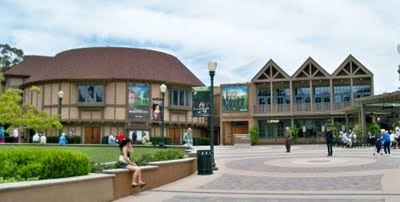
The Old Globe Theatre in San Diego continues to produce quality shows season after season. Last week, I was fortunate to usher one of the final performances of George Gershwin Alone before Hershey Felder, author and performer, retires his one-man show Sunday, July 10th, 2011. He has toured with this show for the last fifteen years., but the performance has been preserved on video for future broadcast. Hearing "Rhapsody in Blue" performed live was a moving experience.
Hershey Felder has performed on Broadway, at London's West End, and over 150 theaters worldwide. He has been a Scholar in Residence at Harvard and is married to Kim Campbell, former Prime Minister of Canada. The man can teach, write, act, perform concert music, and charm audiences with his easy manner and polished performances.
Collaborating for the fourth time with director Joel Zwick (My Big Fat Greek Wedding), Hershey Felder is bringing his latest work to the Globe stage: Maestro: the Art of Leonard Bernstein on July 22nd through August 28th. I am looking forward to ushering this one in a few weeks. George Gershwin Alone and Maestro: the Art of Leonard Bernstein are the last two shows (or movements) in a sonata of four one-man shows called "The Composer Sonata." Two years ago, I saw the first two shows (movements). Beethoven As I knew Him, the first movement, followed by the intermediate romantic movement, Monsieur Chopin. I will have seen the entire "The Composer Sonata" performed live by its creator. What a thrill!
Don't miss this show if you are going to be in San Diego this summer and you are a lover of fine music and virtuoso performances. Felder is a musical genius. www.TheOldGlobe.org
Published on July 09, 2011 14:18
July 2, 2011
Computer Violation
Ever felt like you've been seduced and abandoned, even after you've loaned someone money? If the computer is an extension of the central nervous system, then I've been having a nervous breakdown for about a week. There were signs that things weren't right, but I didn't see them; finally my brain flat lined on Monday. Yes, my computer died. It clicked and stuttered before it seemed to say, "You know it's over."
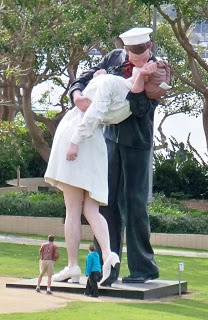 I took it to Office Depot where they "backed up my data" and sold me a bunch of services I didn't need. Finally, when they wanted to put on a gigs more memory, rather than tell me a six year old computer with Windows XP isn't worth upgrading, I said, "Enough."
I took it to Office Depot where they "backed up my data" and sold me a bunch of services I didn't need. Finally, when they wanted to put on a gigs more memory, rather than tell me a six year old computer with Windows XP isn't worth upgrading, I said, "Enough."
I felt like the Beaver: "Hey. Wally, is Eddie giving me the business?" So I took the computer to a better place, the Santee Recycling Center, and started all over again. My new computer has a burly one terabyte of memory on the hard drive, so I'm back in business.
Everything was going along smoothly until I took the thumb drive of my data that Office Depot had saved for me, and entered it into the new computer. There was no address book and none of my emails were on it. Nada! Stripped clean. "#%$*!!!"
This time around, I got smart. I bought a new computer with Windows 7, and I purchased an off sight backup and recovery service. This beast has a terabyte of memory (whatever that is?) on my hard drive. Over this Independence Day weekend, I plan to recover as many email addresses as I can and contemplate how dependent we have all become on rampant technology.
Happy Fourth of July, everyone.
 I took it to Office Depot where they "backed up my data" and sold me a bunch of services I didn't need. Finally, when they wanted to put on a gigs more memory, rather than tell me a six year old computer with Windows XP isn't worth upgrading, I said, "Enough."
I took it to Office Depot where they "backed up my data" and sold me a bunch of services I didn't need. Finally, when they wanted to put on a gigs more memory, rather than tell me a six year old computer with Windows XP isn't worth upgrading, I said, "Enough."I felt like the Beaver: "Hey. Wally, is Eddie giving me the business?" So I took the computer to a better place, the Santee Recycling Center, and started all over again. My new computer has a burly one terabyte of memory on the hard drive, so I'm back in business.
Everything was going along smoothly until I took the thumb drive of my data that Office Depot had saved for me, and entered it into the new computer. There was no address book and none of my emails were on it. Nada! Stripped clean. "#%$*!!!"
This time around, I got smart. I bought a new computer with Windows 7, and I purchased an off sight backup and recovery service. This beast has a terabyte of memory (whatever that is?) on my hard drive. Over this Independence Day weekend, I plan to recover as many email addresses as I can and contemplate how dependent we have all become on rampant technology.
Happy Fourth of July, everyone.
Published on July 02, 2011 00:00
June 28, 2011
Santee Lakes, continued...
 Endangered Wood DuckThe beautiful park, with its seven stepped recreational lakes flowing one into the other, is what the general public sees. But the park is only one aspect of the Santee Water Reclamation Project, which began in 1959. Further north, up into Sycamore Canyon, the business of waste water recycling begins.
Endangered Wood DuckThe beautiful park, with its seven stepped recreational lakes flowing one into the other, is what the general public sees. But the park is only one aspect of the Santee Water Reclamation Project, which began in 1959. Further north, up into Sycamore Canyon, the business of waste water recycling begins.[image error] Used water from Santee residences, not sewage, is pumped into the water reclamation plant where excess flow and sludge is diverted and sent to the San Diego Metro System. The "gray" water is routed to a series of three stabilization ponds with a combined capacity of 40 million gallons. The water, with the help of gravity, works it way through eleven percolation beds, 400 feet long which drain into a French drain.
From there, the water is treated in a chlorination station before it is released into the first of the seven man-made recreational lakes. Once the water works its way through the park, it is pumped into the City of Santee's irrigation system which feeds the commercial Town Center area and also irrigates the Carleton Oaks Country Club.

Historically, many of the American West's worst conflicts were over water rights. That was true 100 years ago, and it's true today. Water Rights is still one of the most contentious issues among the Western states.
Santee Lakes is a successful role model for water conservation with its three use system: household, recreation, and landscape. Check out A&E's Modern Marvels: "Water Conservation" for more information. Saving water is everybody's business because every drop is precious, that's why I'm proud to support my water department's conservation efforts.
Published on June 28, 2011 00:00



